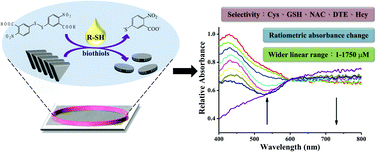Silver nanoprism-based paper as a ratiometric sensor for extending biothiol detection in serum†
Abstract
In this study, we present a selective paper-based method for the detection of L-Cys in serum using DTNB-modified Ag nanoprisms (AgP-DTNB). This method is based on the principle that L-Cys reacts with DTNB in AgP-DTNB to release a TNB2− chromophore and etches simultaneously AgP-DTNB to form Ag nanodisks, hence resulting in ratiometric changes of absorbance. Different biothiols have different affinities to etch the AgP surface and cause nanodisks of different sizes, which have slightly different resonance wavelengths. Thus, L-Cys can be discriminated with different biothiols on the basis of the different absorption spectral changes and different absorbance ratios. The linear dynamic range for the determination of L-Cys was 1–1750 μM, and the correlation coefficient (R2) was 0.9968 (y = 3.0859 × 10−4 [Cys] + 0.9376). The limit of detection for L-Cys was calculated to be 0.87 μM from 3 times the standard deviation of the blanks to the slope of the calibration curve. Compared with the other nanoparticle-based sensors in solution and on paper, AgP-DTNB possesses a much wider linear range and a comparable detection limit for L-Cys. This paper-based sensor exhibits selectivity, a wide linear sensing range, low-volume sampling, miniaturization, portability, and disposability.



 Please wait while we load your content...
Please wait while we load your content...